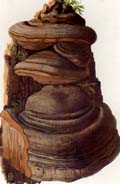 Key to Gilled Mushrooms Key
Key to Gilled Mushrooms KeyThis is a key to gilled mushrooms, that is, mushrooms having a definite cap with a fertile surface consisting of gills. The fruiting body usually also has a stem, although that may be lateral or absent (usually, then, the mushroom is growing from wood). You can use this key to identify mushrooms that you find.
 Polyporaceae Family
Polyporaceae FamilyFertile surface usually a layer of vertical tubes, of which the mouths are visible as pores on the underside of the cap or shelf.
Fruiting bodies usually tougher or harder than the "normal" gilled mushrooms, being leathery, corky, or woody. But they can be quite tender while actively growing
Once grown, they do not decay easily, remaining on the substrate for months or years
They often grow on wood, although a few are terrestrial (even those are usually growing on buried wood)
Fruiting body is usually a flat shelf, or hoof-shaped, protruding directly from the substrate, although sometimes it may have a short stalk.
Some forms never grow away from the substrate at all, so that all that is visible of the fruiting body are the pores.
Sometimes the pores are so minute that the fertile surface seems solid, until you look closely
Echinodontium Genus Everhart & Ellis

Diagnosis
- Fertile surface composed of long (typically 2-3") spines.
-
Fruiting body hard (woody).
-
The top of the cap is usually a dark basic color (like the picture), with bright red and orange flesh and spines
Comments
This genus is extremely rare, and contains one of the few fungal species to have certifiably gone extinct. At the turn of the (previous) century, Echinodontium ballouii used to inhabit Atlantic White Cedar, and endangered species that was in decline. Intensive "management" of the few existing stands of this conifer led to the National Parks Service cutting down infected trees well before the fungus could fruit. Within a few decades, this eliminated the fungus from the face of the planet. Our more "common" Echinodontium tinctorium may not be far behind. (And, as one might have expected, the numbers of Atlantic White Cedar have also continued to decline.Many fungi that inhabit living trees take several decades to fruit. During that time, they are vulnerable to having the tree cut down without having spread their spores. Members of this genus seem to require an especially long period of vegetation, and so are especially vulnerable in this way
Narrow down your identification:






 Key to Gilled Mushrooms Key
Key to Gilled Mushrooms Key Polyporaceae Family
Polyporaceae Family





